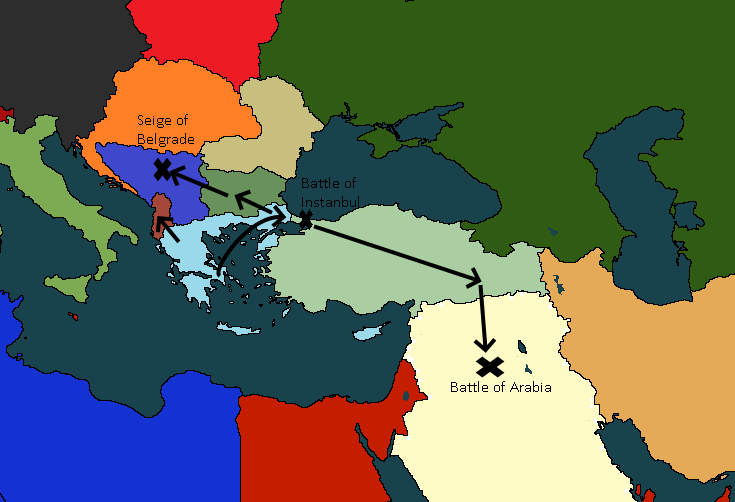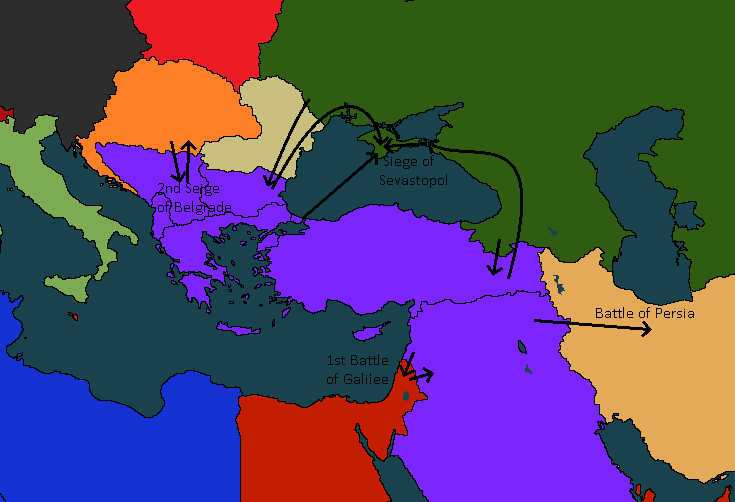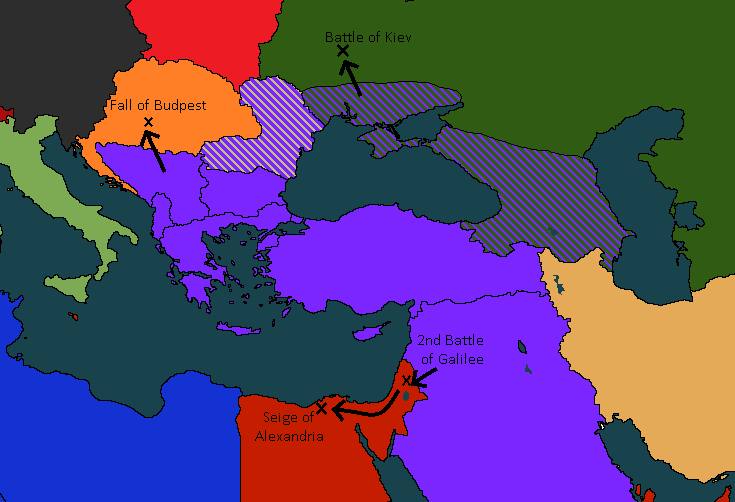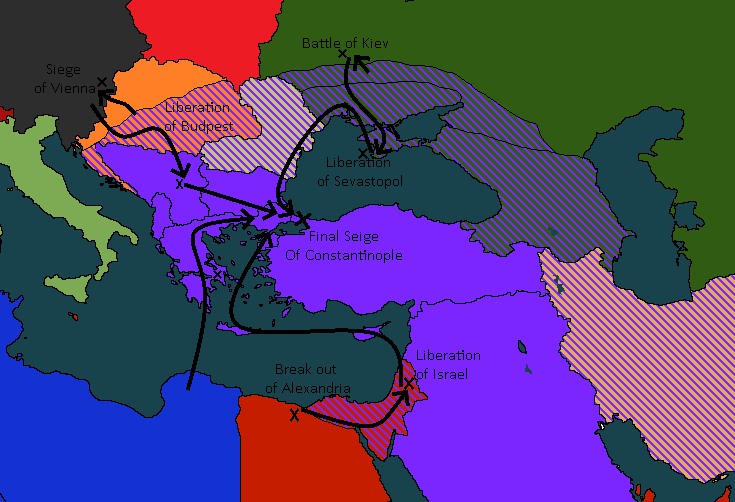The Sixth Yokai Invasion
The Fourth Yokai invasion was the largest war the world has ever seen, involving every major continent and major nation, ending years of peace.
Prelude
The Fourth Yokai invasion began as a regional conflict between the German and British-backed state of Greece and the Russian-backed state of Turkey in April 2041. The Greeks quickly found themselves greatly outmatched despite combined German and British resources. To regain momentum the Greeks accepted the help of Yokai Oni(for more info click) mercenaries who would be paid with conquered land. The mercenaries earned their pay defeating the Turks at the Battle of Istanbul, which was renamed Constantinople by the Greeks. Over the next several months the Yokai and Greeks would push the Turks to the Caucasus without fear of Russian interference due to Germany and Britain. Greece officially annexed Turkey after Turkish forces surrendered following the Battle of Istanbul.
Peace in the region would not last long after a coalition force consisting of: Serbia, Bulgaria, Albania, Arabia, also in control of Syria and Iraq formed intending to undo Greece’s gains, which now called itself Byzantium. Refusing the coalition’s demands and needing more land for the growing number of Yokai mercenaries, Byzantium invaded the coalition, preemptively. Germany and Britain were surprised by Byzantium’s aggressiveness and withdrew their support allowing Russia to levy sanctions. The coalition would quickly fall by the end of 2041, mainly due to a lack of solid leadership and unifying vision and were annexed by Byzantium. The annexation of the coalition territories afterward, were condemned by both Germany and Britain.
The War Officially Begins
Alarmed at losing much of their former land interests and influence in the Balkans and the Middle East, the Russian Empire began preparing a military counter-offensive for several months with its allies Romania and Persia. The Russians made good initial progress in March 2042, however, Byzantium’s naval victory over the Russian Black Sea fleet would turn the tide. A Yokai counter-offensive managed to decisively defeat Romanians and Persian armies at the Battles of Bucharest and Tehran, respectively, removing them from the war, however, the Yokai advance was held up in the Caucasus due to mountainous fortifications. With naval control of the Black Sea, the Yokai landed a major force on the Crimean Peninsula in April 2042 and laid siege to Sevastopol with it falling by mid-July despite Russian attempts to reinforce it. The Siege of Sevastopol would draw troops from the Romanian and Caucasus Mountains front allowing the two Yokai forces to meet up in Crimea in August.
Border skirmishes with Byzantium along the borders of German ally Hungary and the British Protectorate of Israel would push both powers to demand peace with generous terms on the threat of war. Byzantium refused, forcing Germany and Britain to declare war on Byzantium in early September 2042. The allied navies would secure a naval victory in the Aegean, forcing the Byzantium fleet to remain in the harbor for the rest of the war. On land, the German siege of Belgrade was repulsed by Yokai forces. The British meanwhile, were on the defensive with Yokai attacks which were pushed back by the Israel Protectorate. However, the British and German war effort would be upended from an unlikely source, Africa.
Chaos in Africa
Several years prior, the Second Yokai Invasion occurred in Africa during a time when rebellions against Europeans were common. At the time, these rebel groups were supported by the Yokai, when the invasion and rebels were defeated, the rebels went into exile with some of the Yokai.
These rebels had grown in number and would be equipped by the Yokai mercenaries fighting on behalf of Byzantium. Between November 2042 and May 2043, a series of coordinated attacks against lightly garrisoned regions in Africa would enable the various rebel groups to seize most areas except for a few colonies and settlements. Attacks against French colonies in West Africa would encourage them to join the war against the Yokai after securing their colonies. The British would be forced to abandon most of their colonies with the United States occupying Sierra Leone.
British troops would regroup in Alexandria, Egypt and Mombasa, Kenya where they would come under siege. Less problematic were the continuous border skirmishes in Rodiasa and South Africa. Meanwhile, on the front lines, the Yokai would overrun the British in Israel and would join the rebels in the siege of Alexandria. In the north, the Yokai advanced into Hungary and laid siege to Budapest for several months with the city eventually failing. Against the Russians, the Yokai would struggle to push through Ukraine thanks to reinforcing Polish and would thus fail to take Kiev.
Political Struggles within the British Federation
The new situation in Africa threw Britain into chaos. With the loss of the canal and intact supply lines, the British Conservative government planned to evacuate Mombasa and Alexandria to cut its losses, however, decreasing support in Parliament and the threat of military interference halted any evacuation.
A pro-Arthur Allencourt and anti-King John faction, the Britannia Party, had recently gained greater popularity among the federation population as support for the current Conservative government crumbled as it failed to deal with the war. In response, King Johnathon attempted to remove the Prime Minister and take direct control of the government, causing a rift in Parliament. While the Prime Minister was unpopular, the King was seen also as incompetent and most of the MPs had quietly gathered support for his younger sister, Eleanor of House Hannover, to have succeeded their father as monarch. To the King's surprise, the MPs moved fast as enough MPs deserted their previous parties to the new Britannia Party which gave them a large majority. The King would be forced to accept a new Prime Minister from the Britannia Party, Alexander Morgan, a distant relative of Arthur Allencourt.
America and Japan Enters the War
With the new Britannia Party in control of the British Federation, the Empire called in its allies, the United States and the Japanese Empire to shored up its African and new Indian fronts, and re-established imperial supply lines. By the end of June 2043, the empire's collapsing lines had stabilized and American reinforcement troops would end the six-month-long sieges of Mombasa and Alexandria. In July, the American and British Army would break out of Alexandria and envelope the rebel and Yokai armies in Cairo and retake the canal. The cities’ defenses were quickly exploited by its attackers, utilizing a known weak point to get in behind the walls and disable the automated defenses and open the gates. The defenders were overwhelmed fighting to the last man.
Throughout July and August 2043 in Europe, the recently joined French Army and allied German troops would engage the Yokai during the siege of Vienna. The Yokai would break through the outer walls, but the defenders would hold the breach allowing ever more reinforcements to join them. The French-German coalition would engage in and around the city with the Yokai, who eventually retreated to prevent themselves from being surrounded by the German right flank. The French-German coalition would pursue the Yokai as they retreated, retaking an undefended Yokai-controlled Budapest, and laying siege to Yokai-controlled Belgrade, taking the city by the end of September. At the same time, Yokai forces would withdraw to Sevastopol as their advance grounded to a halt with additional Japanese reinforcements to aid the Russians. The Russians slowed the Yokai retreat, however, it could not halt it completely since the Yokai managed to escape even as the Japanese-Russian coalition stormed the city walls.
Siege of Constantinople
The Yokai lines had been broken and were in full retreat on all fronts against the international coalition. The continual need for conquest had proven catastrophic as every great power fought against them now, which proved too much for Byzantium. From October through to December, the Yokai lost control of the Aegean islands and even Athens to the coalition. The Yokai and Byzantium leadership planned to make a stand at the highly formidable defenses of Constantinople with hopes of securing a victory with which peace could be negotiated in the short term.
The advancing coalition of Germans, French, Russians, British, and Americans led by Arthur Allencourt himself, reached the city surrounding it with land fortifications and naval blockade. Arthur began by ordering an allied artillery barrage followed by navel landings on the Anatolian side of the city to complete the envelopment which was met with stiff resistance. With allied battleships surrounding area secured, also not allowing a naval escape route for Yokai-Byzantium forces, coalition forces would begin a large scale bombardment in hopes of destroying the city’s coastal guns, after a week of rotating battleships the coastal guns would cease to fire, allowing new American and British air battleships to safety hover over the city comfortably striking target after target. With large portions of the defenses silenced, ground troops would begin the assault of the European section of the walls.
After ground troops had fought their way to the walls through enemy trenches, the attackers would use previously made holes in the walls to secure a breach. Quickly taking advantage of the breach, the coalition armed core was ordered to expand the breach along with the infantry.
Difficult urban fighting would follow over the next month and into February, but with air and sea supremacy the coalition made steady progress. Eventually, the Yokai were forced into the city’s inner fortress with only a few thousand Yokai left. Fortunately for them, the fortress was the most secure part of the city, forcing Arthur to bring in his new elite core of troops, his new Knights. Arthur would personally lead them into battle securing the gate and slowly pushing through the courtyard until they encountered the Yokai leader. After a vicious engagement in close quarters with swords, Arthur’s men were victorious, Although the Yokai leader survived, he was taken captive by Arthur’s men.
Post War
With the fall of Constantinople, effective resistance ended, and the victors begin peace talks in Berlin in May of 2044. They established the state of Byzantium with hopes of it bringing greater stability to the region. Upon arriving back in London, Arthur Allencourt would use his immense popularity to disband Parliament and replace the King with his wife, Queen Eleanor of Great Britain and Ireland and the Dominions. Pushing ahead with other plans, Arthur declared the new state of Britannia incorporating the United States and the British Federation into a new nation with himself becoming its new Emperor.
With information from the Yokai leader, Britannia and the other major powers began preparations for the Kami’s war to come to Earth.
Start Date
2041 AD
Ending Date
2044 AD
Britannia Political party
The Britannia Party would begin in America as Arthur's new power base following the civil war(for more info click). Its policies would be pro-regionalism, anti-democracy, and anti-socialist and would enact a libertarian-conservative style government across America. The party would expand overseas into the British Federation and expand its platform to include strong support for the Empire and some aspects of monarchy, however, it would be strictly against King John for he was seen as unfit to be king. The Party and movement would be a strong support pillar for the establishment of the United States of Britannia(for more info click). The Britannia Party would begin in America as Arthur's new power base following the civil war. Its policies would be pro-regionalism, anti-democracy, and anti-socialist and would enact a libertarian-conservative style government across America. The party would expand overseas into the British Federation and expand its platform to include strong support for the Empire and some aspects of monarchy, however, it would be strictly against King John for he was seen as unfit to be king. The Party and movement would be a strong support pillar for the establishment of the United States of Britannia.







Comments